Krol, Watze
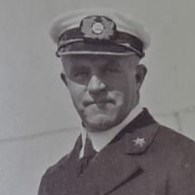
Captain Watze Krol later in his career (f)
Krol; Watze
Note: On his birth certificate and for the family his name was written with an s instead of a “z”. But when he joined Holland America his name was entered with a “z” and kept that way throughout his career. We do not know why, but the name Watse, when pronounced sounds like Watze, thus maybe he found it easier . In the HAL archives his name is only recorded as Watze but in later years communications surfaced where the name of Cornelus is also mentioned.
Born: 11 December 1872 in the town of Vierlingsbeek in the Netherlands.
His father was Gerhardus Leendert Krol (20 Nov. 834 – 1924), born in Lith, and his mother Anna Gijsberta Hamstra (10 Febr. 1839 – 1925) born in Leeuwarden. They married in 1870. If you look at the dates, both parents lived to a ripe old age certainly for those days.
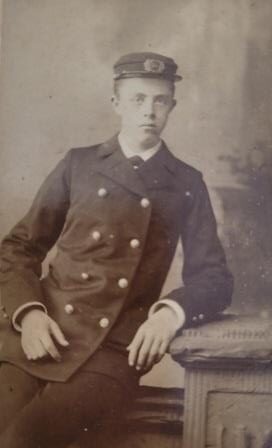
The later Captain Krol as cadet (f)
Father Krol was a preacher (Dutch Reformed) and was assigned to various church communities. He was born in Lith but his son received the very Frisian name of Watse. This as the first name Watze is in the Netherlands mainly used in the northern Province of Friesland and seldom in the southern part of the country where Vierlingsbeek is located. Watze is the Old –Dutch / German reshape of the Latin name of Valentines. Father was assigned to churches in the towns of Vierlingsbeek, Groede and Veghel. Peculiar thing is here that this is an area of the Netherlands which is predominantly Roman Catholic. Father Married in 1870 and there were three children. A daughter, Helena Gerardina born 10 Dec.1871, Our captain, born 11 Dec. 1872 and a 2nd son, Leendert Henri Krol, born 09 Dec. 1881. (c,e,f).
Then no information is available until we learn from the HAL archives that he joined Holland America as a cadet on 29 July 1890 after completing his school training at the Maritime School in Rotterdam. Going to Rotterdam made sense as Vierlingbeek or Vierlingsbeek is located about 50 miles to the East of Rotterdam.
Biography:
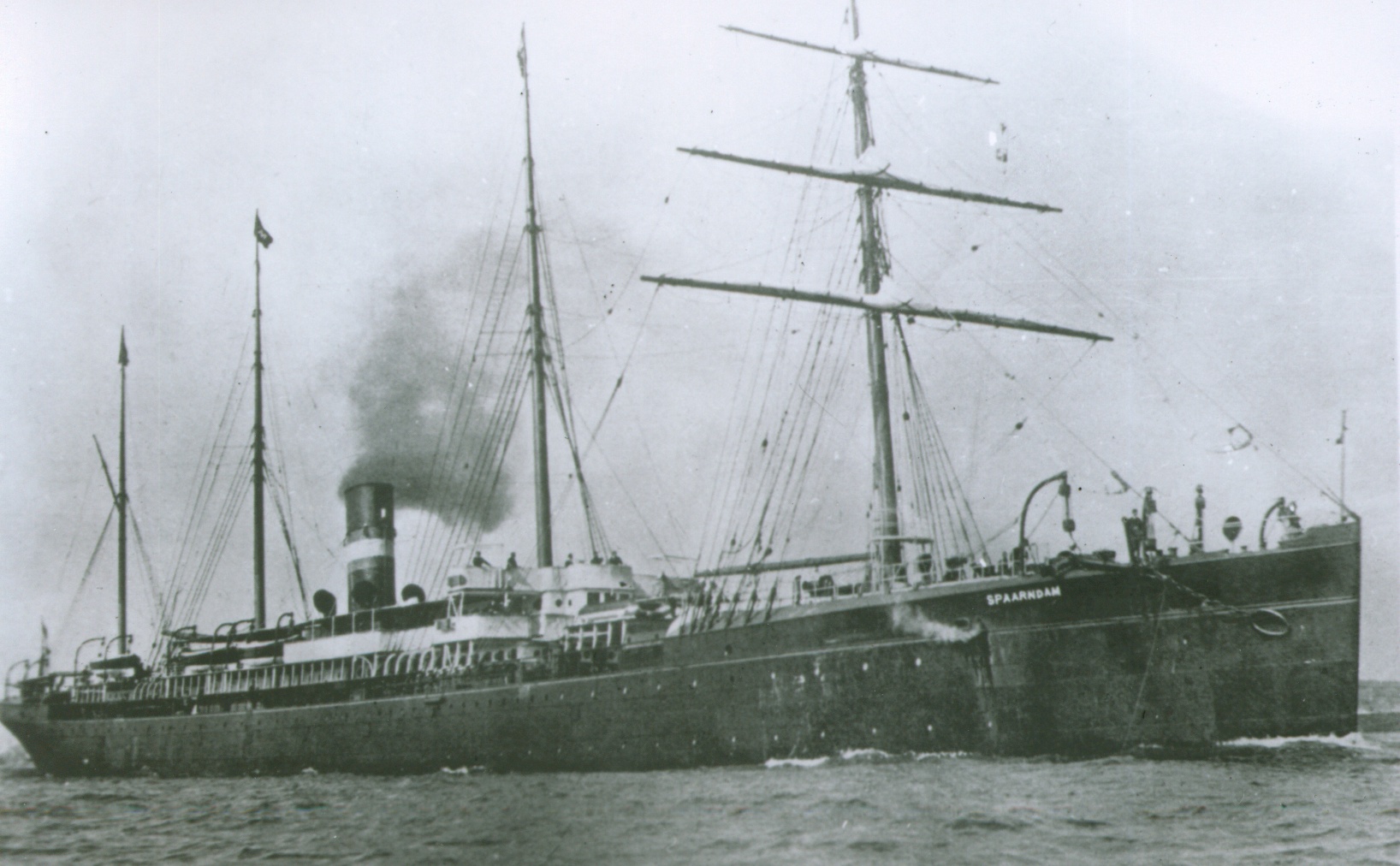
The ss ‘Spaarndam’ (I) in service for Holland America between 1890 and 1901. She had been built as the Arabic for the White Star Line in 1881.
His first ship is the ‘Spaarndam’ (I) which had been bought from the White Star Line some years before and was considered very posh for Holland America Line standards. In November 1891 he returns after obtaining his 3rd mates certificate and is now assigned to the ss ‘Didam’. This was a bit of an unusual ship as it had been constructed for the South American Emigrant trade which was blossoming around 1890. Before Holland America could put two of these especially built ships on this service (There was also the sister ship called the ss ‘Dubbeldam’) a revolution in Argentina stopped all emigration ideas and the ships were sent to the North Atlantic. But for the South American run they had received very large bunker (coal) storage capacities which took up the space where freight could have been stored. As a result the two ships were considered un-economical for the North Atlantic service and sold in 1895/1896.
When checking the list of ships he sailed on, (see at the end of this biography) it is remarkable that he was never on board when something peculiar happened to a ship. In sailors terms we call that “sailing with an angel on your shoulder”. As a result there is not much to tell about the period he went through the ranks until he became Chief Officer.
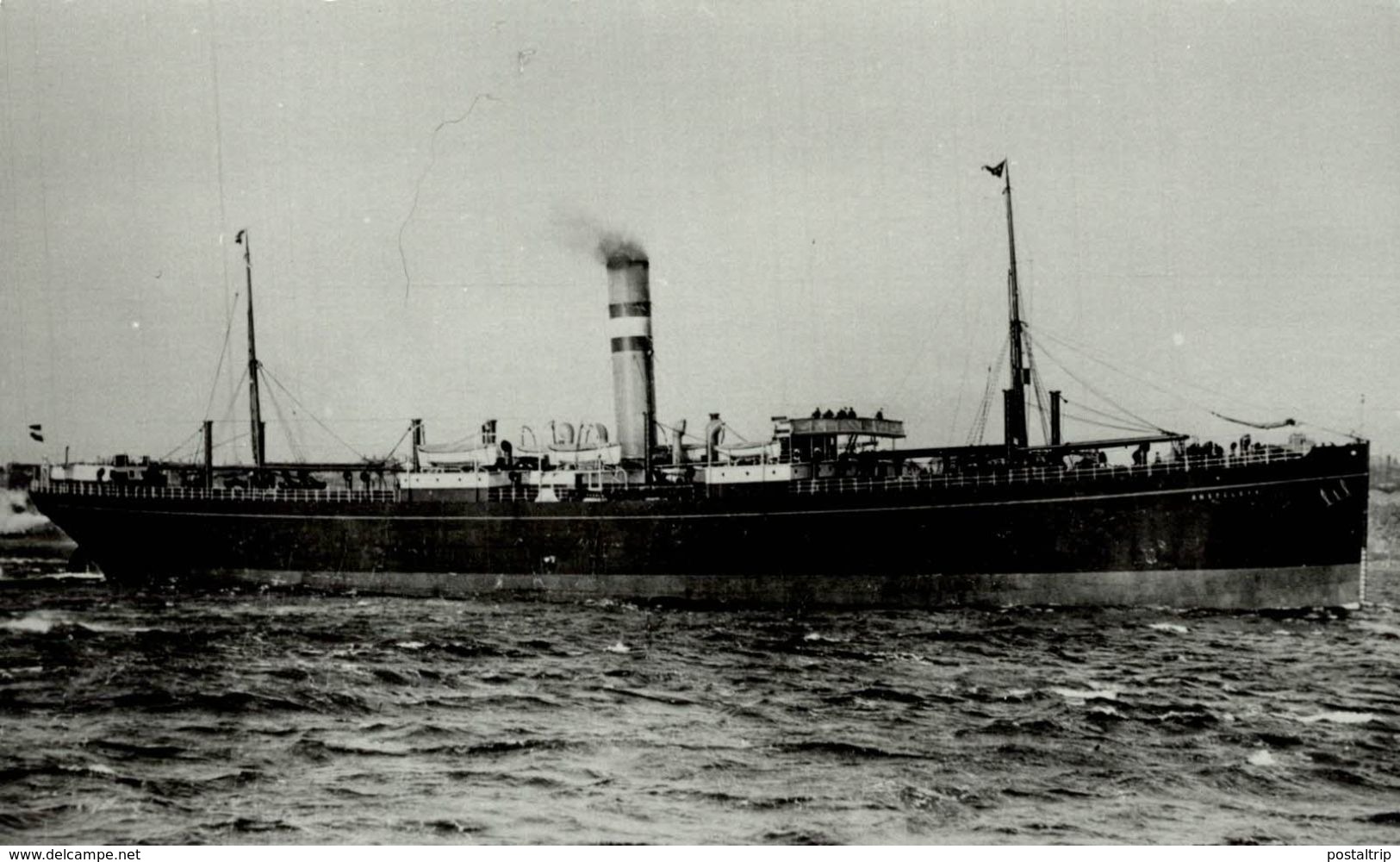
The cargo ship ss ‘Amsteldijk’ (I) She sailed from 1901 to 192 for the company. Apart from carrying regular cargo, she had facilities for 350 head of cattle in upper tween deck.
On 15 Oct. 1901 he joins the ss ‘Amsteldijk’ (I) which had just arrived brand new from the shipyard and Mr. Krol was assigned as acting Chief Officer. His first time as Chief Officer. In the company’s seniority system this would normally not have happened and a more Sr. Chief Officer would have been assigned to a brand new ship but the company was expanding again and if you had the license you got the job.
Then again he has a period of safe sailing were nothing happens to him or is happening with the ships he sails on. All that peace and quiet comes to an end when he becomes the captain of the ss ‘Noordam’ (I) in October 1911 as more and more issues develop due to the threat of a war. The first time he ends up in the newspapers is when he sends the now world famous ice telegram to the Titanic warning ship of dense ice.
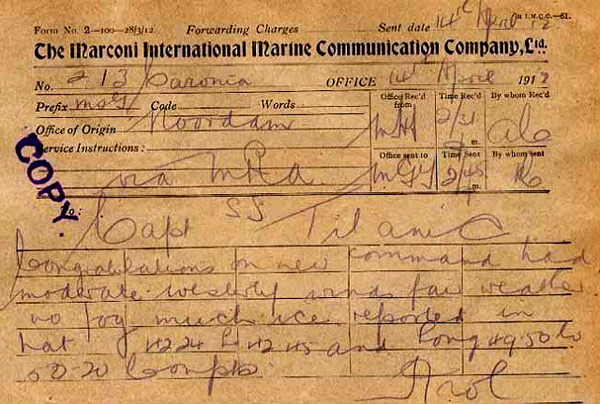
The Noordam – Titanic telegram. Found somewhere on the internet, original source unknown.
Quote:
Capt. Titanic.
Congratulations with your command. Had moderate westerly winds fair weather no fog much ice reported in Lat. 42 – 24 and 42 – 45 and Lon. 49-50 50-20 Compts Krol.
Unquote:
(The Titanic sank in position 41-43.32 North and 49.56.40 West)
The Titanic sinking position is right under the ice field as reported by Capt. Krol reported on the 14th. The Titanic sank on the 15th. So the Titanic’s captain should have taken into consideration that the ice fields in this area come down to the lower latitudes and thus would drift towards his course line. Rumour has it that Captain Smith of the Titanic never even showed the telegram to the officers on the bridge but kept it in his pocket. What happened next is well-known.
Later in the year he comes across the situation that a crew member (fireman) steels a medallion out of his vest while it is hanging in his cabin. The crew member is caught and sentenced to prison. There is no documentation in the newspapers of Captain Krol attending the Court session dealing with this.
Then the war starts and the Kingdom of the Netherlands remains neutral. This was the last war between Empires trying to exert dominance over Europe but the Dutch had their sole interests in the Far East and thus decided to stay out of it. That did not mean that they were completely out of it.
In early Sept. 1914 he is in command of the ss ‘Noordam’ (I) and brings home to the USA over 500 first class passengers (almost double the regular first class capacity) consisting of a lot of politicians who had been holidaying in Europe.
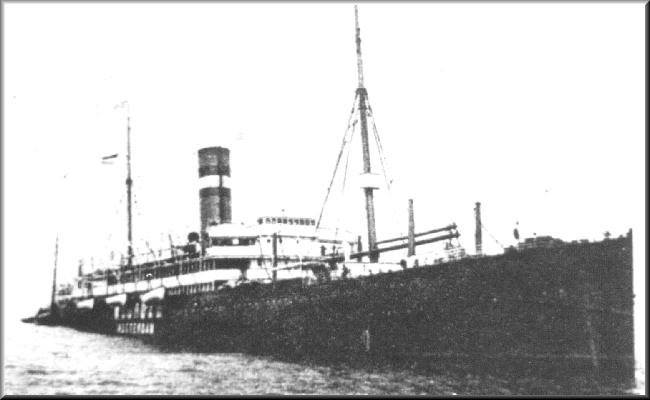
The ss ‘Noordam’ (I) which had entered service in 1901. This photo was taken in 1917 when she hit her 2nd mine. Please note the Name and Homeport on the side of the ship, indicating that she was sailing under neutral flag.
On 9th September 1914 the ‘Noordam’ (I) is arrested while Eastbound by a British Royal Navy ship (The Merchant Cruiser ss ‘Caronia’ = normally sailing for the Cunard Line as a passenger ship) and taken to Queenstown, Ireland. On board was cargo which could be considered to be beneficial to the enemy and 117 men of German, Austrian and Hungarian decent which were deemed to be Military Reserve and on the way home. They were taken off the ship and subsequently made Prisoners of War. The ‘Noordam’ (I) was allowed to sail three days later
On 17 October 1914, the ‘Noordam’ (I) hits a mine which causes considerable damage to the stern of the ship. In dry – dock (The ship remains out of service until April 1915 as a complete new stern is needed) the anchoring wire of the mine is found caught in the propeller. Capt. Krol had somehow managed, with slow speed, to bring the ship safely into Rotterdam. Then he has to face the Board of Inquiry who tries to make him responsible for the disaster as he had ignored a letter from the Dutch Government from two months before indicating the location of the mine fields. But he had obtained the latest information from the British Royal Navy Officers just before departing from the Inspection station at the Downs. The Board is forced to acquit the Captain. (I am writing this in a slightly negative tone, against the Dutch Board of Inquiry, and that is because during both world wars there was a pattern that The Board tried to find fault with the captains who got mined or torpedoed; instead of honouring them as heroes for taking the risk and/or bringing their ships home safely)
Before anything exciting happens again to the ‘Noordam’ (I) (a few years later it hit another mine) Captain Krol is transferred to the ss Potsdam in April 1915. With this ship he only makes one voyage before it is laid up, due to lack of passengers. Shortly after it is sold to Sweden. He himself is transferred to the ‘Nieuw Amsterdam’ (I), the 2nd biggest ship in the fleet (after the ss ‘Rotterdam’ IV) in the coming years he rotates between these ships, the ‘Rotterdam’ (IV), ‘Noordam’ (I) and the ‘Rijndam’ (I). While these ships sail continuously until 1917, the captains are given some more leave, against the stress, and thus the senior captains rotate over these ships. Due to the increasing U-boat treat, more passenger ships are laid up, either in Holland or in the USA. Eventually, only the ‘Nieuw Amsterdam’ (I) continues, as he had approval from both sides of the conflict to keep sailing in order to provide a life line to the Netherlands which were caught between both sides.
Before we make it to the next stage in the proceedings, Captain Krol managed to get married. Having been a sort of perennial bachelor for 43 years he finally tied the knot on 3 Feb. 1916 when he married Miss Clara Horstman (born in the Dutch Indies where her father was a reverend) in the town of Ginneken en Bavel. Eventually there were 3 children. Elisabeth (1917), Anna Gijsberta (1919) and Helena Gerarda (1926 – 19 Feb. 2021) (c)
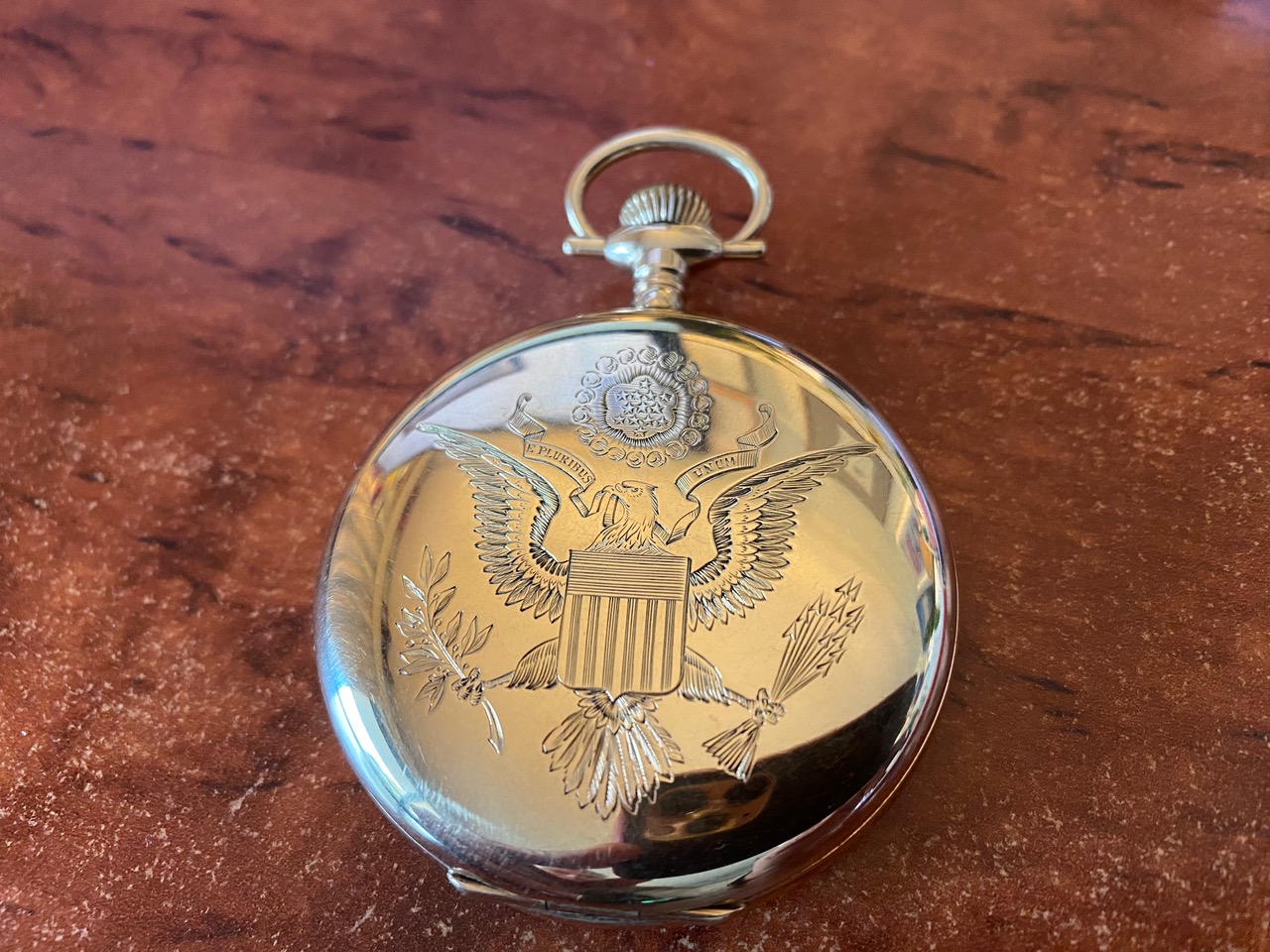
Front Cover of Presidents watch (e)
This captain’s rotation sees him back on the ‘Rijndam’ (I) in 1916 when on 29 Oct. he saves the crew of the US tugboat Vigilant outside New York. He then makes the newspapers on 20 April 1917 when prizes are awarded for the rescue of the tugboat. While in command he has a boat lowered which, while battling high seas, manages to save the complete crew.
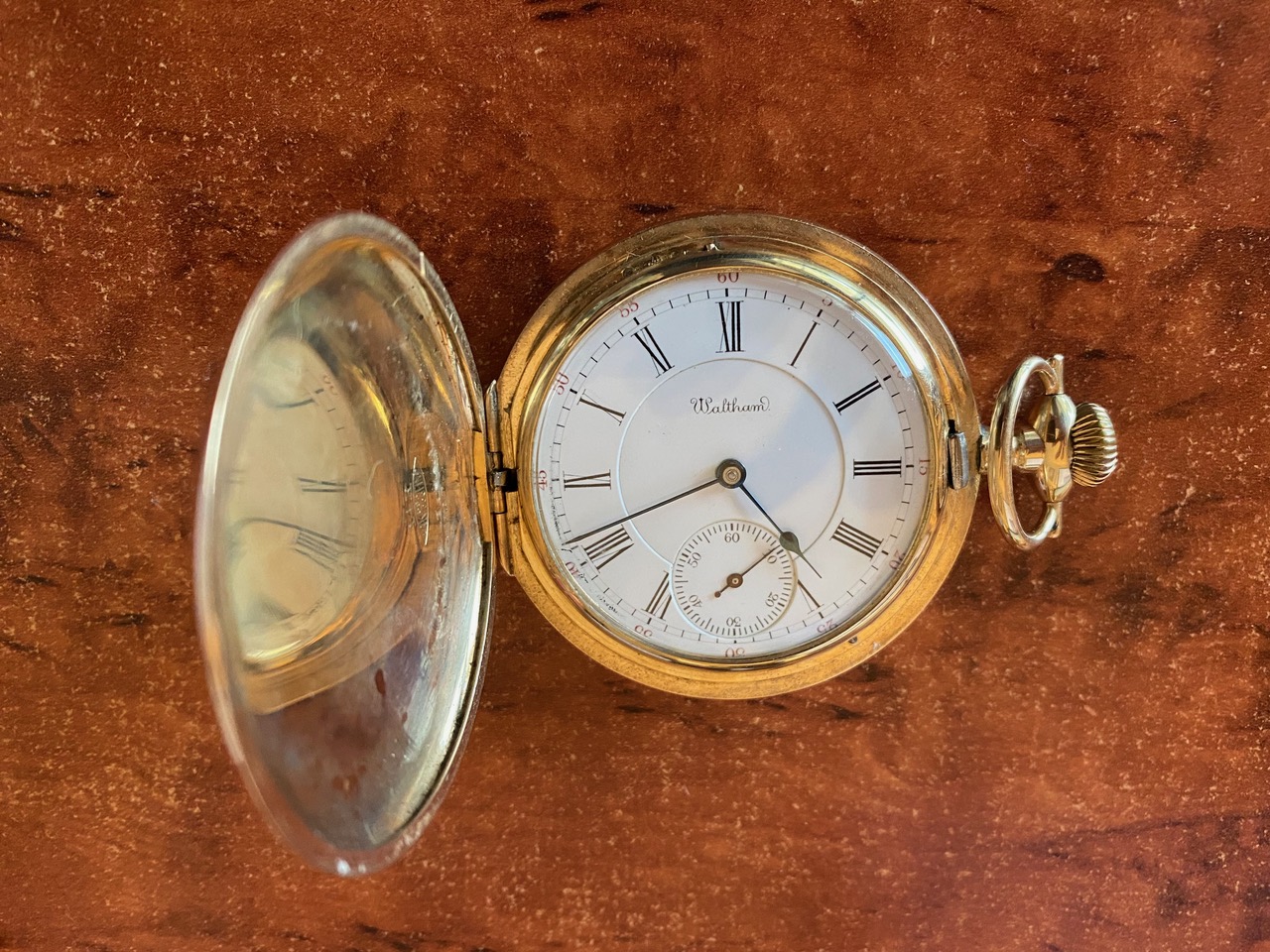
Front Inside of Watch (e)
Captain and volunteers for the rescue all receive a gold medal from the President of the United States. The chief officer who commanded the lifeboat also received a pair of binoculars (*) and captain Krol a gold watch with chain. The newspapers reported that the seas were very high and it was most difficult to reach the sinking tugboat.
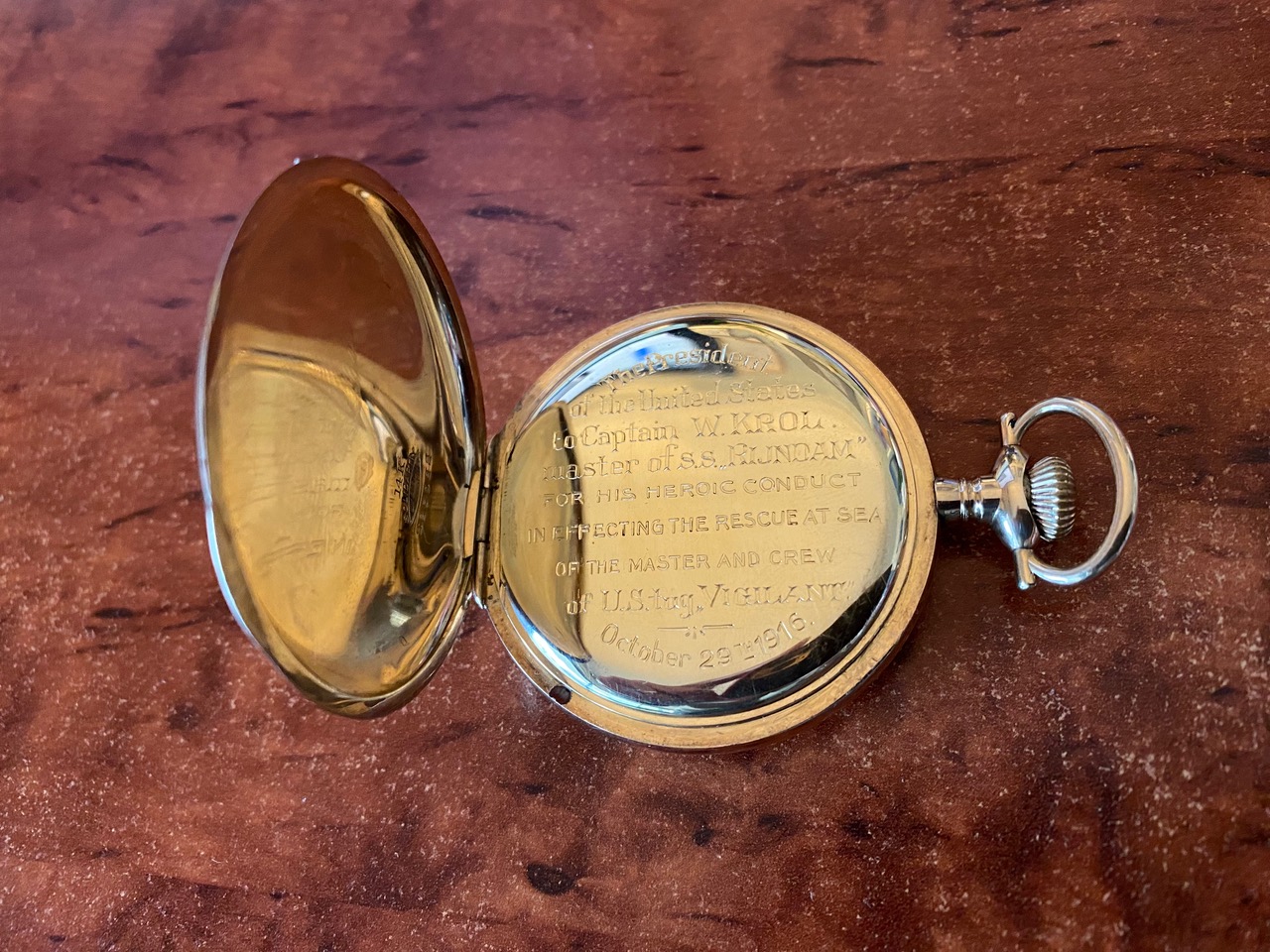
Back Inside of watch (e)
Text of the watch: The President of the United States to Captain W. KROL. master of the ss “RIJNDAM” for his heroic conduct in effecting the rescue at sea of the Master and Crew of the US tug “VIGILANT”. October 29th. 1916.
The first class guests who had followed the effort, presented the Captain with a flattering testimony, upon the safe completion of the rescue. (*) the Chief Officer was Jan Pieter Wepster who later made captain and can thus also be found on his website.
The complete citation reads:
In recognition of the humanitarian and heroic services rendered by the Captain and the Crew of the Dutch Steamship Rijndam during the rescue at sea, on 29 October 1916. of the Captain and the crew of the American Tugboat “Vigilant” has the President of the United States of America gifted to the Captain a Golden Watch with Chain, to the First Officer a pair of Sea Binoculars and to each of the six members of the crew a Gold medal. These six were: Hendrik Vermijs, Hubertus Gloppert, Adriaan de Zeeuw, Karel Christiaan Delvoye, Jacob Lammert Ommen and Hendrik Leentvaar.
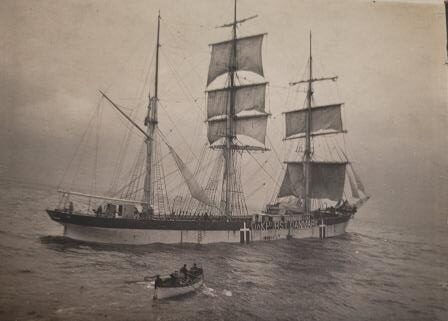
The barque ‘Oakhurst’. We see the lifeboat of the ”Rijndam’ (I) going over to help. Please note the Danish flags and the letters OAKHURST DANMARK on the side. Denmark was , as was the Netherlands, neutral in the First World War, so captain Krol did not risk an international conflict by helping the ship. (f)
Shortly after on 16 December 1916 the ‘Rijndam’ assisted the Danish Barque ‘Oakhurst’. The ship was found at 50o 08N – 016o15W. and was on the way from Norresundby to Buenos Aires. the captain advised that due to heavy seas two man had been lost overboard, one killed on board and one injured with a broken leg. Also all the magnetic compasses were gone. Captain Krol decided to take the injured crewmember on board and transfer new compasses to the barque. the sailing ship then decided to sail to Queenstown (now Cobh in Ireland). the injured crewmember as landed by the ‘Rijndam’ in Falmouth England.
In March 1918 he is back on the Nieuw Amsterdam (I) and then transports home from New York, 79 captains, 306 officers and 1854 crew. These were all sailors from various Dutch ships that were laid up in the USA. On 21 march 1918 the USA confiscated all these ships for the war effort to speed up the transport of troops and equipment to Belgium. As the Netherlands was neutral, the Dutch crew could no longer sail on their ships as the USA was flagging them in. This gave the peculiar situation that a younger captain was in command of the more senior ship, while the sr. captain (van den Heuvel) was on board as a passenger as he had rotated over the ‘Rijndam’ (I) which was confiscated. The ‘Nieuw Amsterdam’ (I) was the only ship not seized as it was deemed necessary to continue a token passenger service to the Netherlands and to bring each return voyage a large quantities of grain. Grain desperately needed as the Netherlands normally imported grain from Germany but that had now stopped due to the war.
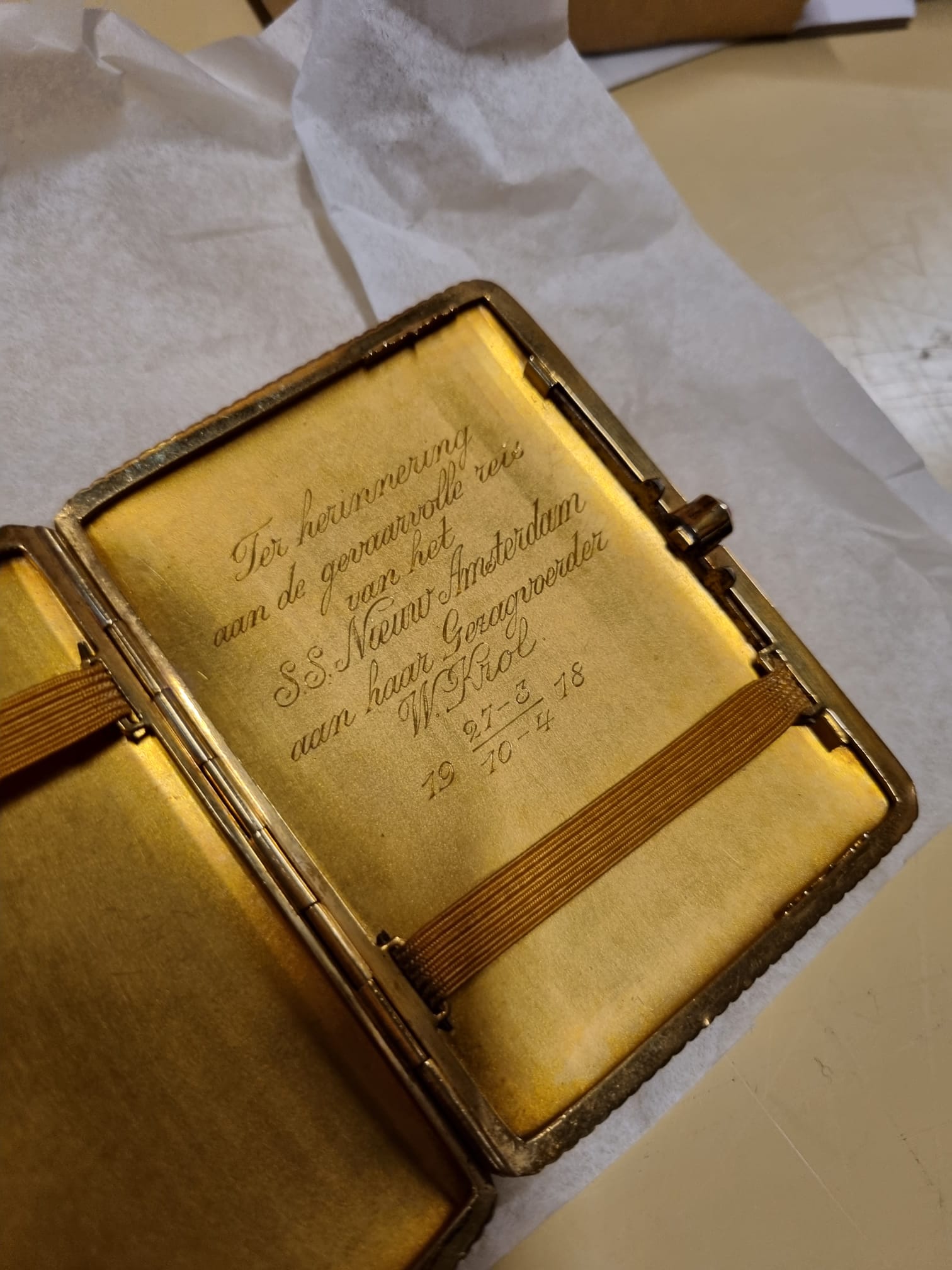
Cigarette holder presented to Captain Krol in April 1918 (f). This item is now part of the collection of the Maritime Museum in Rotterdam
Note: In the family collection is a golden cigarette holder with the inscription: “As a memorial to the dangerous voyage of the ss ‘Nieuw Amsterdam’ (I) to her Commander W. Krol 27 March 1918 to 10 April 1918”. This was voyage 96 EB going from New York to Rotterdam travelling north of Scotland and coming south via the Doggersbank. it is unknown what was “dangerous” about this sailing but as the text is in Dutch it could be that it was presented by the combined Dutch Crews who were returning home with the ship after their own ships were confiscated by the Americans for the war effort.
(ED: if any reader could confirm this, please send an email to Captalbert1@aol.com)
With the war at sea intensifying, it is getting more and more nerve racking to make the crossings but he is still lucky. If there were any U-boats / submarines who spotted the ship, they all respected the neutrality agreement. In August 1918 the ship is stopped in mid Atlantic by a German submarine but the ‘Nieuw Amsterdam’ (I) can sail on. In November the war comes to an end and that sees all the ships return to service. The ‘Rijndam ‘(I) is dismissed from US war service and Captain Krol reboards her on 07 Aug. 1919 and remains with her to Feb. 1923for the regular North Atlantic service.
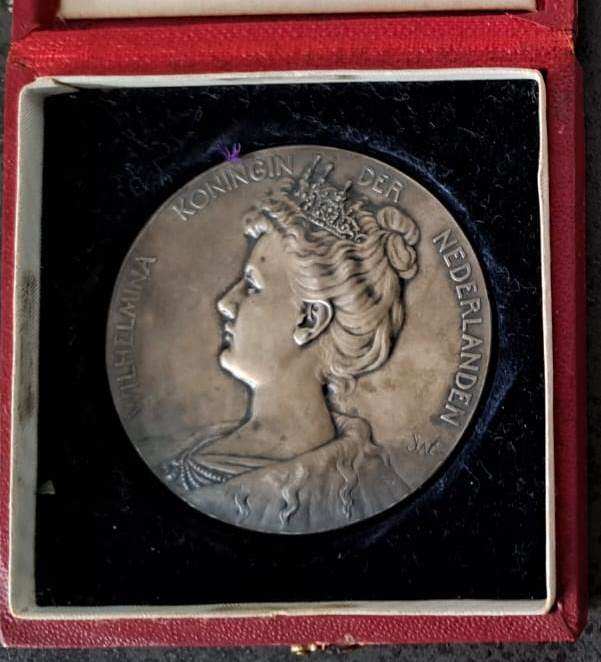
Medal presented by the Netherlands Meteorological Institute in 1914 (f)
In June 1920 he receives the Gold Medal from the Royal Dutch Meteorological Institute for the quality of the weather observations in the ships logbooks. This medal was issued yearly in gold and silver. In general the more senior captains qualified for gold and the younger ones for silver. He had already received the silver version in 1914.
He is once again in the spotlights, although more in the shadow of it, when Holland America line announces that the ‘Rijndam’ (I) is transporting the youngest ever – not officially escorted – passenger, a little girl of 2 years old. No doubt the crew would have ensured that she would have had the crossing of her life.
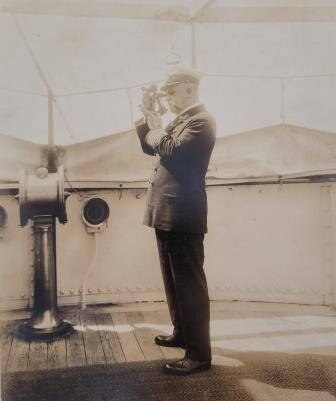
Captain Krol on a publicity photo on board the new ss Veendam (II) (f)
Via the new ss ‘Volendam’ (I), the captain ends up on the new ss ‘Veendam’ (II) in March 1924 and remains there until 1929. Here he sees Holland America slowly entering the cruise business with more sailings every year. While most of the year the ship is on the regular North Atlantic service from Rotterdam to New York, in March 1926 a month long Caribbean cruise is made from New York. Although in those days they called it a cruise to the West Indies. In 1926 there are three, in 1927 there are 3 more, same as in 1928.
On 15 July 1927 while inbound for New York, the ship hits the Norwegian Steamer ss ‘Sagaland’ which is cut in half and sinks within 15 minutes. The 20 crew manage to jump over onto the ‘Veendam’ (II). 5 jumped into the water and 4 were saved by the lifeboats of the ‘Veendam’ (II). One man was presumed lost after a search of the area proved in vain. The collision happened in dense fog. The ‘Veendam’ was travelling with a speed of about 13 knots and suddenly the fog lifted, the ‘Sagaland’ which was also moving, appeared. A collision could not be avoided. The Captain who was on the bridge, ordered at once Full Astern, but it was too late. The ‘Sagaland’ did not take any action and its engine was still on forward motion after the collision had occurred. There was later in the year a Board of Inquiry investigation and the whole focus was on the fact whether 13 knots was too fast in the fog. Captain Krol thought it was not. Full speed of the Veendam (II) was near the 20 knots and going down to 13 knots was a considerable reduction. The Board did not agree but was also reluctant to react too strongly and issued an official Reprimand for speeding.
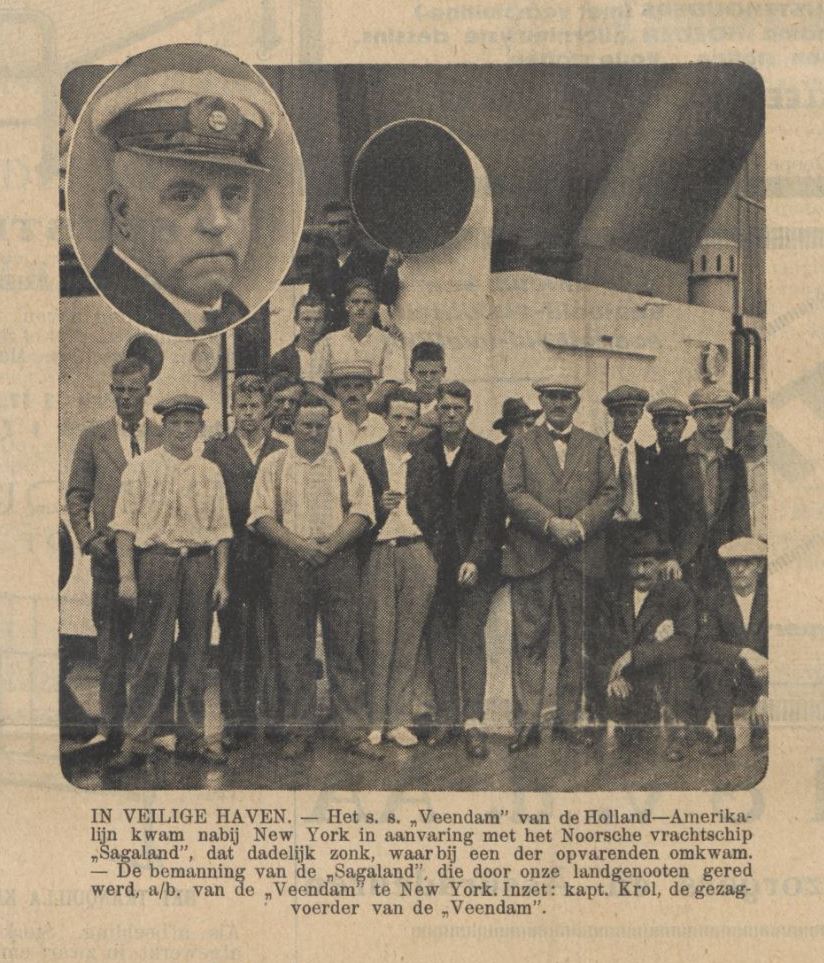
The saved crew of the ss ‘Sagaland’. From a contemporary Dutch Newspaper. The caption reads: In Safe Harbour – The ss ‘Veendam’ of the Holland America was in collision near New York with the Norwegian freighter ‘Sagaland’ which sunk at once during which one of the crew died. The crew of the ‘Sagaland’ which was saved by our own fellow countrymen , on board of the ‘Veendam’ in New York. Insert, Capt. Krol Commander of the ‘Veendam’.
In 1928 on May 12, the ship departs from New York but goes to anchor because of the dense fog. While at anchor she is hit by the ss ‘Puerto Rico.’ Although the Engine room is filling up, Capt. Krol, together with some Engineering magic manages to bring the ship back to the pier at Hoboken where it settles in the mud. The passengers are disembarked and repairs last from 20 May to 16 June. Again the Captain has to appear before the Board of Inquiry and they now deliberate whether it was a good idea to go at anchor in the flog or whether the ship should have sailed to another area. This gave rise in the Dutch Newspapers to the joke: “The best Navigators can be found ashore, your are wrong when you sail and you are wrong when you do not sail.” The Board wisely decided to let it go.
(ED: Did these two occurrences affect his career? No. If one follows the bumps and dents and other happenings of various captains in the old days, the company always decided on its own whether the captain was culpable or not and it did not take much notice of what the Board of Inquiry came up with)
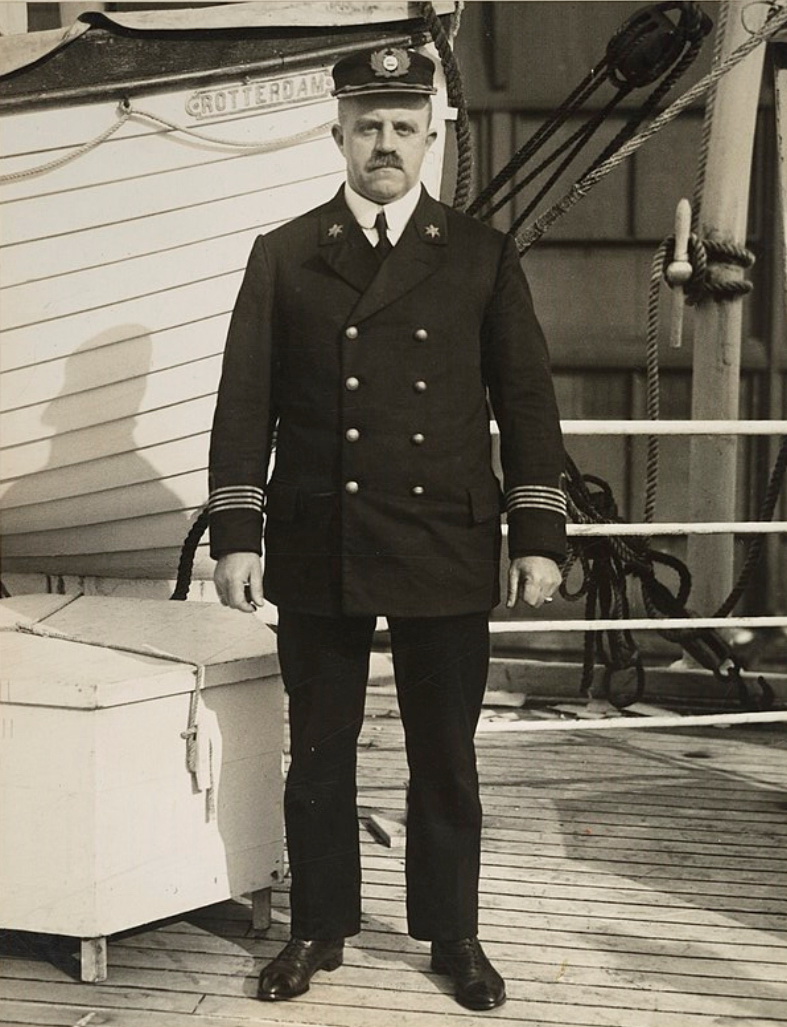
Captain Krol. This photo was taken between Jan. and Dec 1929 as it was the only period he was on the ss ‘Rotterdam’ (IV) (Courtesy: Original owner unknown)
Then there is a short spell on the ss Rotterdam IV before he transfers to the ss ‘Statendam’ (III)
Promoted on 07 December 1929, when sailing from Rotterdam to New York, to Commodore of the Holland America Line; He takes over command from Commodore Pieter van den Heuvel who retires. The ss ‘Statendam’ (III), which is the flagship, then starts a series of 4 cruises from New York in charter of a well-known local agency Raymond & Withcomb. This is then repeated for the next few years around and after the New Year when there is no work for the ship on the North Atlantic due to the depression years. Although emigration and business travel has stopped, there are still enough people out there who have money to make a cruise.
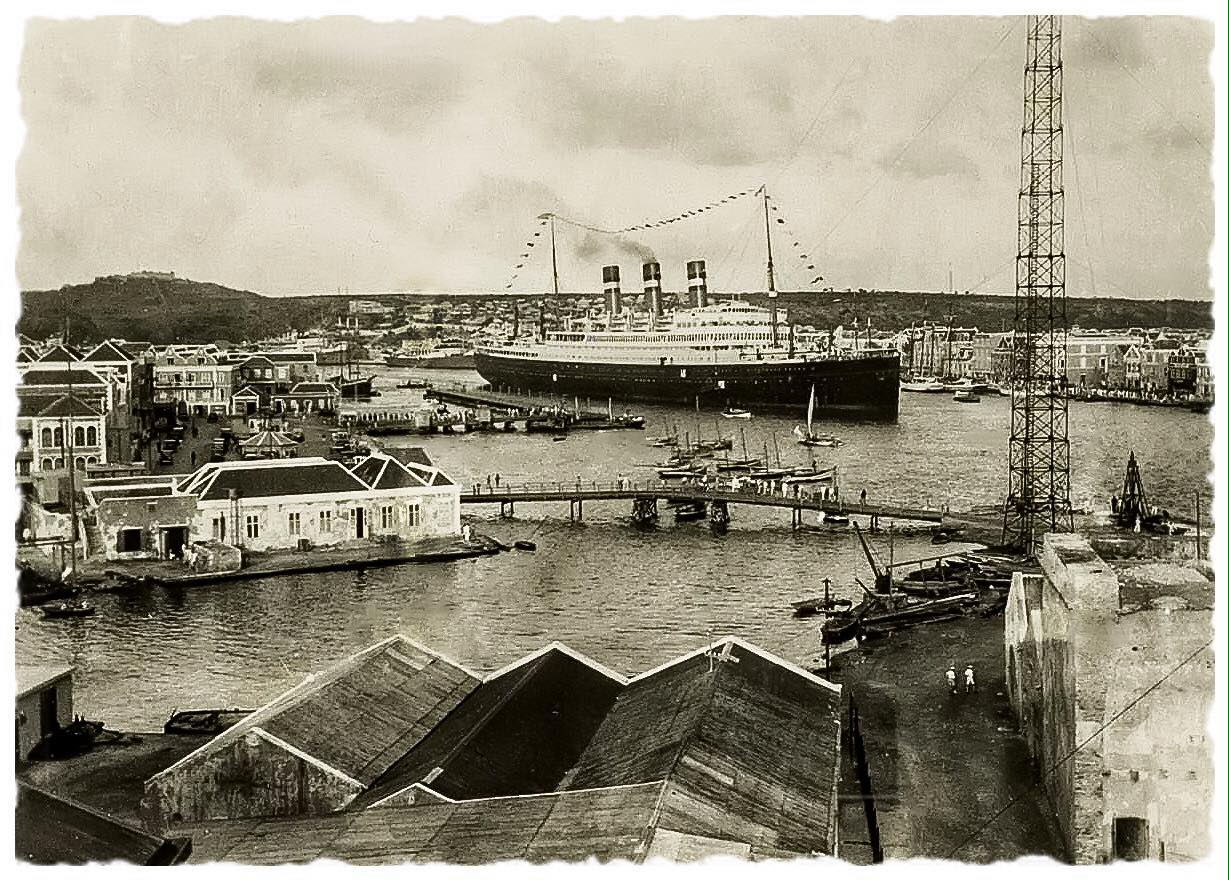
The ss ‘Statendam’ (III) in St. Annabaai Willemstad. Roughly at the same location where the smaller cruise ships nowadays dock. (Although these current “smaller” cruise ships are about double the size of the ss ‘Statendam’ (III).
During one of these cruises, on 07 May 1931, he takes the ‘Statendam’ (III) into the Annabaai and Schottegat in Willemstad while the whole shipping world was convinced it was not possible. Everybody considered the ship much too big. Captain Krol proves the opposite and it seemed that the nay-sayers where much too pessimistic as in years to come much larger cruise ships entered the port. Cruise ships who had the same engine configuration as the ‘Statendam’ (III). Around the same time, the ‘Statendam’ (III) under his command is also the largest passenger ship that enters the port of San Juan. Puerto Rico.
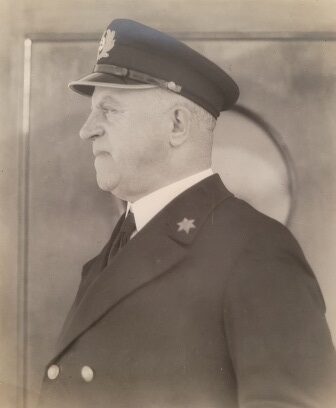
Capt Krol late in his career. (f)
He retires on 28 March 1932 while on the crossing home with the ‘Statendam’ (III). For this purpose Capt. Bijl (who lived in the States) had boarded in New York.
Upon his retirement he received a painting from the Board of Directors of the Holland America Line called “Schepen in de Maashaven”. The Maashaven was one of the side ports in Rotterdam connected to the river Maas which flows through Rotterdam.

“Schepen in de Maashaven” painted by J.H van Mastenbroek in 1928. The family donated this painting in later years to the Maritime Museum in Rotterdam. (f)
ED: It still has to be ascertained why the retired this way. The mandatory retirement age was 60 years in those days and he was 8 Months short of that on the other hand he had clocked up more than 40 years at sea.
The Dutch Royal Navy Records indicated did he never really retired, although the company records say so. It looks more like it that he was put on the non-active or standby list, as on 01 January 1939 he is promoted to Captain Luitenant of the Dutch Royal Navy. Being still attached to the navy must have made it possible for him to be “roped in” for the function mentioned below.
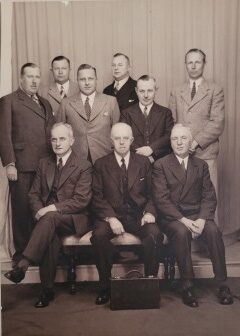
The group of international observers in Gibraltar. Capt. Krol is sitting in the middle. (f)
This was by no means the end of his career as on 12 April 1937 he becomes a member of the International Board for Non-Intervention in Spain and is stationed at Gibraltar for two years. This was an International Organisation established by 27 countries to monitor shipping in relation to the Civil War raging in Spain. Capt. Krol was appointed COO (Chief Observing Officer) for the Sea Observation Scheme, and shortly after appointed to CSO (Chief Staff Officer) with the duties of inspecting ships to ensure that these ships, coming through the Straits of Gibraltar, where not supplying one side or the other. He carried out that function to great acclaim for two years. Then he was appointed CSO in Oran on 28 March as the post in Gibraltar was disbanded. Oran was shortly after disbanded as well and then he returned home. (e)
Then he is called back by the Royal Netherlands Navy. Due to the threatening war The Dutch Royal Navy established a “Hoofdbureau Zeeverkeer” (Main office for Sea Transport) on 07 April 1939. They appointed a retired Rear Admiral F.J Heeris to lead this new department and one of the first things he did was to get outside experience by means of Commodore Krol who was Royal Navy Reserve (Rtd.) anyway, so he knew the Royal Navy very well. Mr. Heeris returned to active duty on 13 Sept. 1939 and we do not know how long Commodore Krol remained involved. It must have stopped at the latest with the invasion of the Netherlands on 10 May 1940. This Sea Transport department was very important for the Merchant Navy as it devised a Code – Name system to advise the fleet about important events. Also It was this department who gave on 06 Sep. 1939 the order for the Neutrality signs to appear on the sides of the ships. (Flag and country in bold letters and colours) (d)
In 1942 the German Occupier arrests all the Dutch military (land, sea and air) leaving in the Netherlands and sends them to concentration camps in Germany. This included may reserve officers but Captain Krol must have been excluded most likely due to his age. as he had just turned 70. He then got involved with what was later called the “Netherlands Escapes Lines”. These were individuals who (loosely connected through the Dutch Resistance) who sheltered allied airmen who had crashed in occupied territory and were helped to get home. by that time Capt. Krol was living in Rotterdam and (as per his USA case file) provided housing, food and clothing for a month to Lt. Ashley and Lt. lee navigators of the USAAF. they had been shot down in the area and ended up via a local reverend with Capt. Krol. The (declassified) case file does not give the dates of when the airmen were there, so we do not know if they were there together or came through one by one.
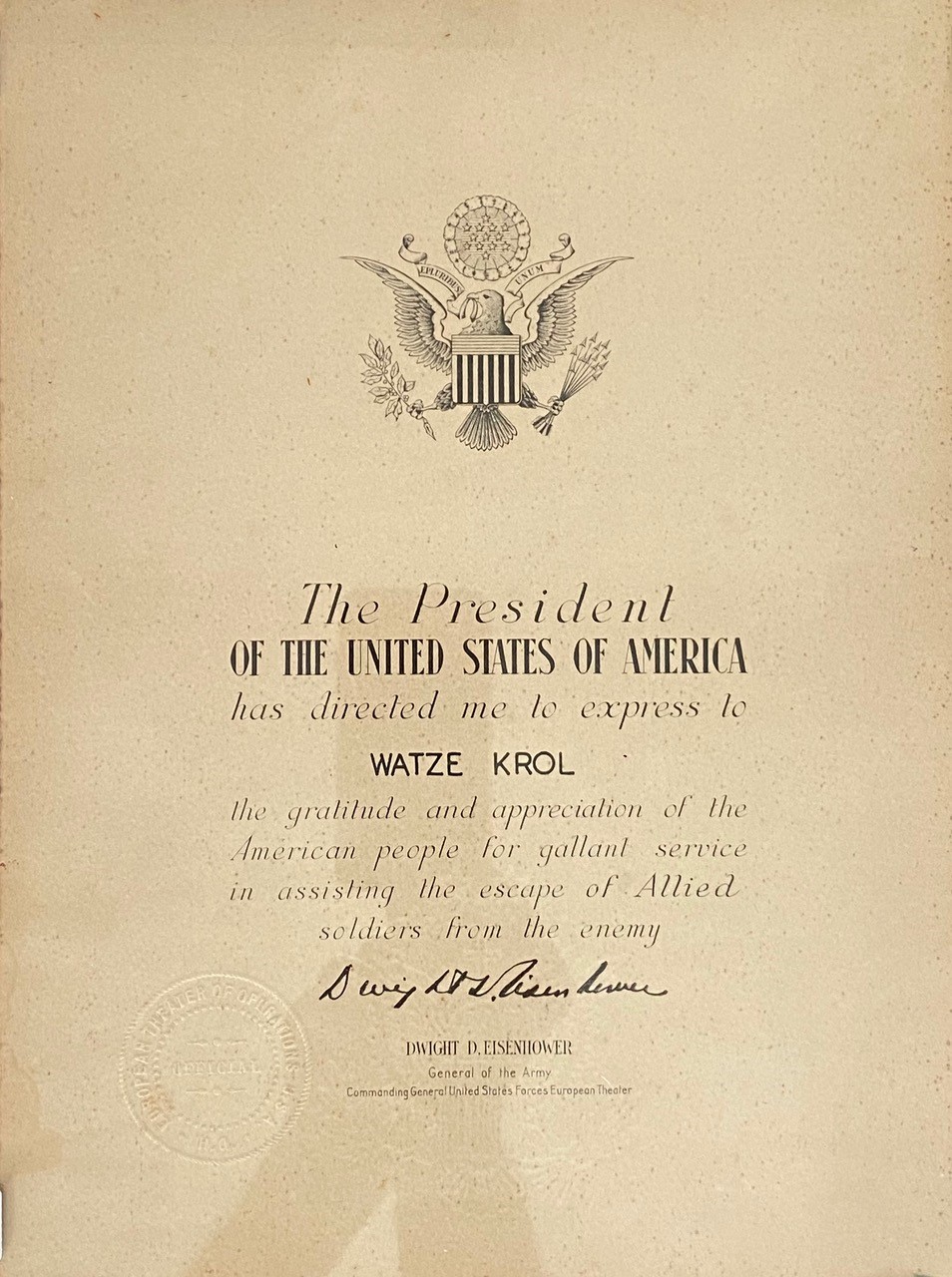 His support was reviewed by the US Government in December 1945 and afterwards he was presented with a certificate thanking him for the help given to US service personnel. Family lore advised that his daughter “Anne” was a member of the Dutch Resistance (called the Underground / Ondergrondse in the Netherlands) and she often guided Bomber crews to the Belgian border where the Belgian resistance took over. This certificate hung, until her death at the age of 94) in the Hall way of his eldest daughter Elise. (e.f)
His support was reviewed by the US Government in December 1945 and afterwards he was presented with a certificate thanking him for the help given to US service personnel. Family lore advised that his daughter “Anne” was a member of the Dutch Resistance (called the Underground / Ondergrondse in the Netherlands) and she often guided Bomber crews to the Belgian border where the Belgian resistance took over. This certificate hung, until her death at the age of 94) in the Hall way of his eldest daughter Elise. (e.f)
Capt. Krol passed away on 14 June, 1954 in Haarlem at the age of 81. Three years after his wife.

Captain’s Signature. Found this on the top of a farewell dinner menu from the 1920’s.
Listing of sailing periods:
Date: Function: Ship: Wages and/or remarks.
29 Jul. 1890 Cadet Spaarndam 5,–
04 Dec. 1890 Cadet Spaarndam 10,–
23 Apr. 1891 Cadet Spaarndam 15,-
22 Aug. 1891 Temporary dismissed for school
17 Nov. 1891 Passed exam for 3rd Mate.
22 Nov. 1891 4th. Officer Didam 30,–
28 Mar. 1892 Temporary dismissed for military (sea) service.
10 Nov. 1892 4th. Officer Veendam 30,–
04 May.1893 3rd. Officer Veendam 50,–
15 Jan. 1894 Temporary dismissed to go to school for 2nd mates license
17 Mar. 1894 3rd officer Veendam 50,–
21 Aug. 1894 3rd. Officer Schiedam 50,–
14 Dec. 1894 3rd Officer Dubbeldam 50,–
25 Dec. 1894 Temporary dismissed for service with the Dutch Royal Navy. (registration number 118)
Appointed as Ensign Extraordinaire,
01 Apr. 1895 3rd Officer Veendam 50,–
29 Oct. 1895 Temporary dismissed to go to school for 2nd mates license
11 Dec. 1895 Passed exam for 2nd mate.
21 Jan. 1896 Acting 2nd Officer Edam 60,–
17 Mar. 1896 3rd Officer Edam 60,–
26 Apr. 1896 Act. 2nd officer Obdam 70,–
23 Jun. 1896 Temporary dismissed
20 Jul. 1896 Act. 2nd Officer Edam 70,–
19 Jul. 1897 2nd Officer Maasdam 70,–
07 Dec. 1897 Temporary dismissed for the Royal Navy.
04 Jan. 1898 Appointed ensign First Class Dutch Royal Navy.
(note) According to the navy records he was promoted on 01 Oct. 1897) (f)
05 Jul. 1898 2nd Officer Rotterdam 70,–
13 Mar. 1899 Temporary dismissed to go to school for 1st mates license
14 Jun. 1899 Passed exam for 1st Mate.
27 Jun. 1899 2nd Officer Rotterdam 70,–
26 Apr. 1901 Temporary dismissed for the Royal Navy
01 May. 1901 Stationed on board Hr Ms Reinier Claessenz
05 Aug. 1901 Act. Chief Officer Maasdam 90,–
15 Oct. 1901 Act. Chief Officer Amsteldijk 90,–
01 Jan. 1892 Promoted to Luitenant 2nd class. Dutch Royal Navy.
03 Mar. 1902 Chief Officer Sloterdijk 100,-
15 Dec.1902 Temporary dismissed for 6month training with the royal Navy.
01 Jul. 1903 Chief Officer Sloterdijk 100,–
14 Sep. 1903 Chief Officer Soestdijk 100,–
05 Jul. 1904 Chief Officer Amsteldijk 100,–
22 Feb. 1905 Chief Officer Noordam 100,–
18 Jul. 1905 Temporary dismissed for the Royal Netherlands Navy.
01 Aug. 1905 Assigned for 3 month exercise on board HMS Bellona at Willemsoord
and from 18 Sept. on board HMS Heiligerlee at Amsterdam
02 Nov. 1905 Chief Officer Sloterdijk 100,–
15 Nov. 1905 Chief Officer Statendam 100,-
12 May.1906 Chief Officer Nieuw Amsterdam 100,–
02 Jan. 1907 Chief Officer Rijndam 100,–
08 Feb. 1908 Chief Officer Nieuw Amsterdam 100,-
25 Dec. 1908 Temporary dismissed for the Royal Netherlands Navy.
31 Mar. 1909 Captain Maartensdijk 200,-
One voyage per ss Rapallo (later Maartendsdijk to and from Baltimore)
20 Jul. 1909 Captain Amsteldijk 200,–
01 Jan. 1911 Due the wage review salary set to 250,–
07 Mar. 1911 Captain Andijk 250,-
26 Oct. 1911 Captain Noordam 250,–
14 Aug. 1914 Captain. Received permission to fly the Navy Reserve flag while in command of HAL ships.
24 Dec. 1914 Temporary dismissed for Royal Navy.
11 Feb. 1915 Promoted to Luitenant First Class
Dutch Royal Navy Resevve. (f)
24 Apr. 1915 Captain Potsdam 250,–
03 Aug. 1915 Temporary dismissed for Royal Navy.
19 Oct. 1915 Captain Rotterdam 250,–
24 Nov. 1915 Captain Nieuw Amsterdam 250,–
01 Jan. 1916 wages increased 300,–
20 Mar. 1916 Captain Rijndam 300,–
01 Jun. 1917 Temporary ashore
05 Jan. 1918 Captain Nieuw Amsterdam 300,–
14 May. 1918 Temporary ashore for standby.
01 Aug. 1918 Wages increased 350,–
13 Dec. 1918 Captain Nieuw Amsterdam 350,–
20 Feb. 1919 Temporary ashore
05 Mar. 1919 Captain Noordam 350,–
22 Apr. 1919 temporary ashore
07 Aug. 1919 Captain Rijndam 725,–
(With the Noordam to New York)
01 Jan. 1920 Wages increase 750,–
16 Feb. 1920 Honorary discharge from the Royal Netherlands Navy. (But kept on the books for the future) (f)
15 Oct. 1920 wages increase 775,–
16 Oct. 1921 wages decreased 710.—
13 Feb. 1923 Temporary ashore
09 Mar. 1923 Captain Volendam 710.—
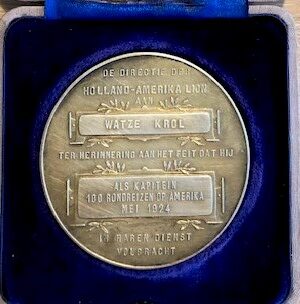
100 voyage medal issued in May 1924 . All Captains and Chief Engineers received a medal for 100 and 200 crossings on the North Atlantic. The tradition came to an end when the ships began making more and more crossings. (f)
11 Dec. 1923 Captain Veendam 710,–
25 Feb. 1924 Temporary ashore
24 Mar. 1924 Captain Veendam 710,–
01 Dec. 1925 Wages increase 735,–
01 Apr. 1927 Wages increase 755,–
01 Jan. 1929 Captain Rotterdam 755,–
01 Jan. 1929 Wages increase 775,–
02 Dec. 1929 Captain Statendam 775,–
01 Jan. 1930 Wages increased 785,–
16 Dec. 1931 Wages decreased to 628,–
08 Apr. 1932 Temporary ashore 628,–
01 May.1932 Dismissed and put on stand by wages
Retired.
01 Jan. 1939 Promoted to Captain Luitenant Dutch Royal Navy. Reserve (f)
14 jun. 1954 Deceased.
(a) Holland Amerika Lijn Archives as held by the Municipal Archives of the City of Rotterdam.
(b) Photo obtained via Mr. Donald van der Horst. Original source unknown.
(c) Mr. E.H Kruidhof (for all the family tree information)
(d) Mr. Theodoor Strauss.
(e) Made available by a family member.
(f) Mrs. Edith van Weel grand daughter. (Daughter of the captains youngest Daughter Helena Gerarda)
Last Updated: 31 Oct. 2023

September 27, 2018 at 4:25 pm
Bron: Geschiedenis van de Nederlandse Koopvaardij in de Tweede Wereldoorlog; K.W.L. Bezemer (p. 71):
Kort na het uitbreken van de Tweede Wereldoorlog, werd op 13 september 1939 werd F. J. Heeris, Schout-bij Nacht titulair, benoemd tot Hoofd van het Bureau Zeeverkeer,….. Een van zijn eerste stappen was een echte koopvaardijman aan te trekken, oud-commodore van de Holland Amerika Lijn: W. Krol.
August 16, 2021 at 2:40 pm
Naar aanleiding van bovengenoemd bericht van John van Kuijk weet ik, kleindochter van Watze Krol dat mijn grootvader voor de tweede wereldoorlog nog een jaar of 2 uitgezonden was naar Gibraltar, ik meen door het Ministerie van Marine(Defensie)
Helaas kan ik het fijne er niet over vertellen daar mijn moeder, de jongste dochter van Watze Krol , op 19 februari 2021 overleden is
August 19, 2021 at 4:37 pm
Mijn dank voor uw informatie. Ik zal het toeveogen als een mogelijkheid. Mischien krijgen we ooit uitsluitsel want er zijn mensen die bezig zijn om de hele KMR teonderzoeken.
mvg
Capt. albert
December 6, 2022 at 11:38 am
Ik wil even een correctie aanbrengen op gegevens mijn grootvader:
Zijn vader was geboren in 1834 in Lith maar zijn moeder Anna Gijsberta Hamstra was geboren in Leeuwarden vandaar dat mijn grootvader de Friese naam Watse kreeg bij geboorte. (waarom hij ook als Watze bekend stond weet ik niet)
mvrgr Edith van Weel
December 12, 2022 at 2:20 pm
mijn dank,
it maak de correctie. Waarom Watze met een z weet ik ook niet, maar zo staat hij vermeld in de persoons gegevens opgetekend met zijn aanname bij de HAL.
mvg
Capt. albert
December 25, 2022 at 2:58 pm
Wilt U mij een mail sturen zodat ik U info en foto s kan terugsturen.
February 3, 2023 at 9:35 pm
Zijn naam komt in elk geval (zonder mil. reg. nr. voor) bij de Marine in de lijst personeelsdossiers.
https://www.defensie.nl/onderwerpen/militaire-geschiedenis-nimh/downloads/publicaties/2010/04/15/militaire-voorouders-koninklijke-marine-geboren-1850-1908
February 4, 2023 at 8:04 am
Mijn dank,
ik hoop dat tzt de KM nog een complete lijst produceert want op deze lijst mist nog al het een en ander, zoals Kapitein Bonjer (allereerste KMR officier) Kapt. Jan Baron (geboren 1861) Kapt. Aldert Potjer (geboren 1859) etc. Kapitein Krol was van de volgende lichting en die staat er dus wel op.
Capt. Albert